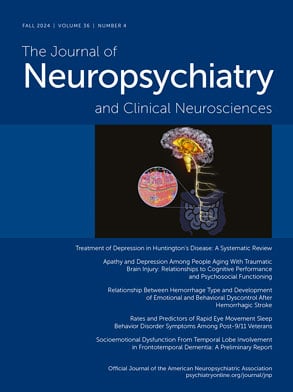To the Editor : Wilson’s disease is associated with neuropsychiatric disorders such as psychosis, depression, and movement disorders.
1 Mania is an uncommon neuropsychiatric manifestation in Wilson’s disease. We report a young woman with Wilson’s disease who developed manic symptoms while awaiting a liver transplant.
Case Report
Miss AC, a 19-year-old woman, had been diagnosed with Wilson’s disease 2 years before the onset of her neuropsychiatric manifestations. She had developed ascites and other features suggestive of chronic liver disease. Her liver function tests, serum ceruloplasmin levels, urine copper levels, and serum copper levels were suggestive of Wilson’s disease. An ultrasound of the abdomen revealed a cirrhotic liver with portal hypertension. A brain MRI did not reveal any abnormality. A slit lamp examination done by the ophthalmologist revealed bilateral Kayser-Flescher rings, and she was started on D-penicillamine, 750 mg/day. Since there was a progressive deterioration in her liver function, a liver transplant was advised by the gastroenterologist. Due to the pending investigations of the patient, the liver transplant was planned at a later date and her mother gave consent for partial liver donation. During this period, she developed insomnia, increased talkativeness and increased activity. She had no past or family history of psychiatric illness.
The patient was transferred to psychiatry for management of these behavioral problems. Her mental status examination revealed overfamiliarity, distractibility, euphoric affect, increased psychomotor activity, and delusions of grandiosity with poor insight and judgment. She was started on a regimen of tablet haloperidol, 10 mg per day, in divided doses along with tablet promethazine, 15 mg, in divided doses. The dose of haloperidol was increased to 20 mg in divided doses after which she had significant extrapyramidal symptoms. Therefore the dosage was decreased to 10 mg per day; on reevaluation after 1 week her symptoms had decreased considerably. She was discharged and prescribed haloperidol, 7.5 mg per day, in divided doses and advised to have close follow-up. The patient is well maintained on a regimen of haloperidol, 7.5 mg/day on follow-up.
Mood stabilizers like sodium valproate and carbamazepine were not started because of poor hepatic function and because elevated fasting blood glucose levels made atypicals a poor choice in this woman. Considering the possibility of renal tubular acidosis in Wilson’s disease and a history of polyuria, treatment with lithium carbonate was also withheld.
1 Patients with Wilson’s disease are exquisitely sensitive to extrapyramidal side effects, and the dose titration should be gradual if typical antipsychotics are used, and they should be started at a lower dose.
2 There are no specific guidelines regarding the treatment of neuropsychiatric manifestations in Wilson’s disease. Medications for psychosis and mania that have been used include quetiapine, clozapine and haloperidol, as well as ECT.
1,
3 There is a paucity of literature available regarding the treatment options in psychiatrically ill patients with Wilson’s disease. Multi-system involvement in Wilson’s disease can make the traditional medications difficult to use in these patients, and treatment regimens may need to be individualized.

